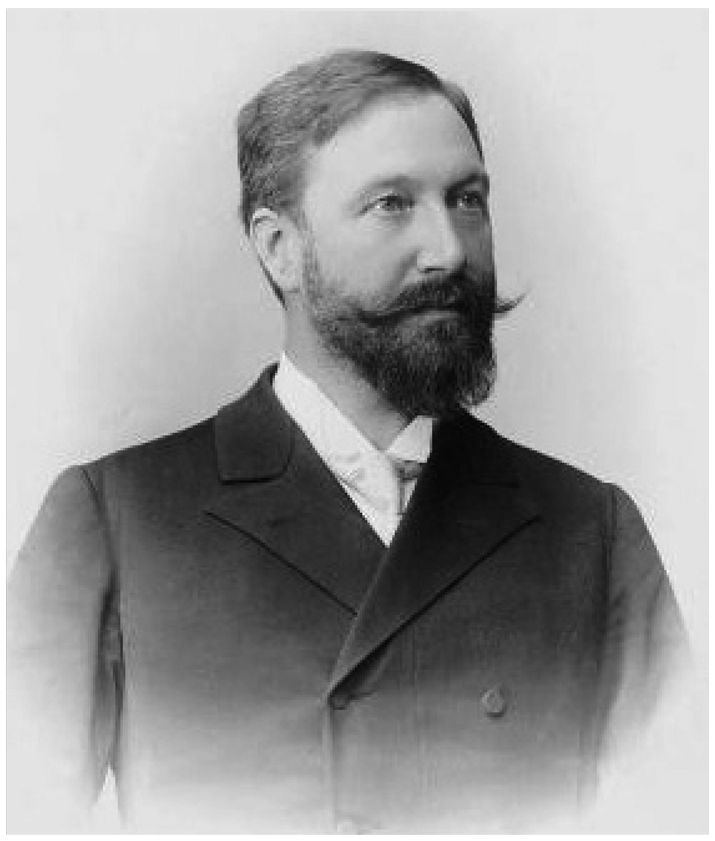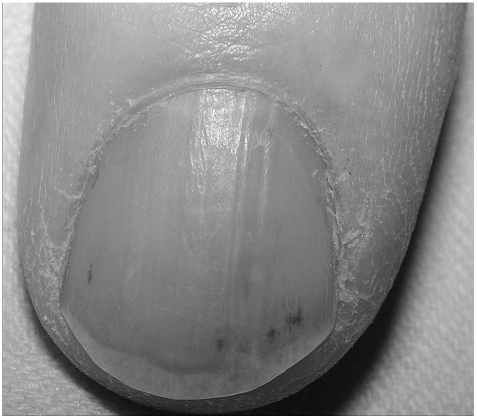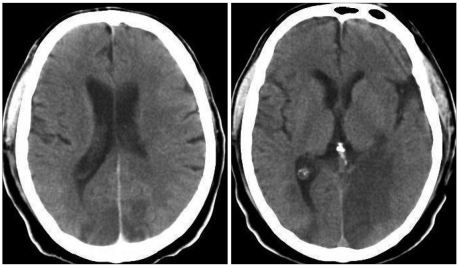Abstract
Anton's syndrome is arguably the most striking form of anosognosia. Patients with this syndrome behave as if they can see despite their obvious blindness. Although best known for his description of asomatognosia and visual anosognosia, Gabriel Anton (1858-1933) made other significant contributions to the clinical neurosciences, including pioneering work in neurosurgery, neuropsychology, and child psychiatry. However, it has not been recognized in the English literature that Anton was also a dedicated advocate of eugenics and racial hygiene. This paper provides a case of Anton's syndrome and puts the works of Gabriel Anton into their historic context.
Keywords: anosognosia, cerebral infarction, disconnection syndrome, endocarditis, euthanasia, Nazi, racial hygiene
Introduction
Anton's syndrome is the most striking form of anosognosia. Patients with this syndrome behave as if they can see despite their obvious lack of sight;1 confabulation is frequent. Cortical blindness is due to bilateral damage of the occipital lobes secondary to hypoxia, vasospasm, or cardiac embolism. Ano-sognosia is often associated with concomitant dysfunction of the parietal lobe, more often on the right side than on the left.2 It is frequently believed to represent a cortical phenomenon, but anosognosia is probably more often caused by parietal white-matter injury leading to a disconnection syndrome.3,4 As a result, the area of the parietal cortex that integrates visual with other sensory information is separated from inter- and in-trahemispheric association pathways.3
Case Report
A 55-year-old man presented with a 3-week history of fever and night sweats followed by the sudden onset of odd behavior. He bumped into tables and chairs, was unable to reach out for a cup of coffee that was put in front of him, and noticed friends and family only when they talked to him. Despite the fact that he had obviously lost his sight and needed assistance in all activities of daily living, he did not complain. He denied being blind and came up with excuses whenever confronted with his handicap. He did not hesitate to describe details in his environment that apparently did not exist.
Physician: How are you?
Patient: Fine.
Physician: Anything wrong with you?
Patient: No. Everything's perfect.
Physician: Anything wrong with your vision?
Patient: No. Works fine.
Physician (showing a pen): Then can you tell me what this is?
Patient: Doc, it's so dark here; nobody can see anything.
Physician (puts the light on although it is plain daylight): I put the light on. Can you now see what I have here?
Patient: Look, I don't want to play games with you.
Physician (who is long and slender): Fair enough. But can you describe how I look?
Patient: Sure. You are a small fat chap.
The examination revealed a systolic murmur and subungual splinter hemorrhages in all fingers (Fig. 1). Transesophageal echocardiography revealed aortic valve vegetations. A diagnosis of infective endocarditis was made and empirical antibiotic treatment started. Despite various attempts, the infective agent could not be identified. Computed tomography of the brain revealed infarction of both occipital lobes and the subcortical white matter of the left parietal lobe (Fig. 2). Anticoagulants were withheld due to the risk of cerebral hemorrhage from mycotic aneurysms. The patient received an aortic valvular prosthesis, and there were no further episodes of cerebral embolism. Within 2 weeks of the surgery, the patient gradually realized that he was blind, but remained rather unconcerned. He was not able to regain independence despite prolonged rehabilitation.
Fig. 1.
Multiple subungual splinter hemorrhages secondary to infective endocarditis. Less common causes of splinter hemorrhages include rheumatological disorders, malignancy, psoriasis, and peptic ulcer disease.
Fig. 2.
Computed tomography of the brain revealed infarction of both occipital lobes and of the subcortical white matter of the left parietal lobe.
The life of Gabriel Anton (1858-1933)
Gabriel Anton (July 28, 1858-January 3, 1933)(Fig. 3) was an Austrian neurologist and psychiatrist, born in Saaz, Bohemia. His early professional work was performed in Prague (1882), Vienna (1887), Innsbruck (1891), and Graz (1894). In 1899 Anton described the syndrome that later came to bear his name.1 In 1905 he succeeded Carl Wernicke as chairperson of the Department of Psychiatry and Nervous Diseases in Halle, Germany. Anton worked together with many outstanding neuroscientists, including Theodor Meynert (1833-1892; Meynert's basal nucleus), Hans Chiari (1851-1916; Chiari malformation), and Arnold Pick (1851-1924; Pick's dementia). In 1908, together with Fritz Gustav von Bramann, Anton developed the "Balkenstich" procedure, where cerebrospinal fluid (CSF) was drained from the lateral ventricles by punctur-ing the corpus callosum.5 In 1917 Anton and Viktor Schmieden proposed suboccipital puncture as another method of decreasing intracranial pressure by establishing CSF outflow through an incision of the atlanto-occipital membrane.6 Anton also made important contributions to the understanding of the basal ganglia.7 In addition, he established free public institutions for mentally retarded children in Graz, Austria, and Halle, Germany. Anton was "a man of sensitive modesty [...] who enjoyed the admiration and friendship of his colleagues and students. [He was] an exemplary warm-hearted physician. Never would a patient leave him without some words of comfort."8
Fig. 3.

Gabriel Anton (1858-1933), circa 1890.
Politically, Anton was a nationalist, a "true German."8 In a speech given 1925 at the University of Halle, Anton referred to France as the "land of the enemy" and complained that "the worst intellectual epidemic the world has seen [...] is the hate against the German people."9 He continued, "All our ambitions, our hopes and worries are united in the concern for the fatherland-and hereby we mean the entire and undivided fatherland."9 (On June 28, 1919, at the end of World War I, Germany had signed the Treaty of Versailles and thereby lost several of its European territories, including large parts of Prussia, Alsace, Lorraine, and Silesia.) However, it should be noted that there is no evidence that Anton was an anti-Semite.
As stated in an obituary from 1933, Anton "bravely pursu-ed the restoration and welfare of the German race."8 Already in 1915, when eugenics and racial hygiene were rarely debat-ed in Austria and Germany, Anton publicly advocated "superior breeding" (German, Höherzüchtung) and "selection" in order to "build a brave and noble race."10 Like many scientists of his time, he believed that racial hygiene was a scientific method of improving society.10,11 In 1925, during his speech in Halle, Anton gave a detailed account of eugenics: "In light of present knowledge, it is no longer reasonable to passively follow the hereditary decline of entire families and the here-ditary inferiority and diseases as in an ancient Greek tragedy. [...] The successful individual"s frequent performance at the highest level demands a mental concentration, a sacrifice also in a physical sense, which is often detrimental to the activities of reproduction. [The result is] a constant self-eradication of the successful individual. [We have to] take precautions in order to protect and improve [...] the quality of the race. [...] It should be our directive that [the physician"s] service to the race is also the service to the individual and vice versa."9
Although Anton did not explicitly encourage euthanasia, his choice of words concerning the means of eugenics is open to interpretation: "One might admit that the sometimes cruel eradication of inferior forms by nature is not always applicable in mankind, but there are now means and reasons to combat at least the eradication and self-eradication of the competent and productive individual."9
The phenomenon of physicians openly advocating eugenics and racial hygiene was widespread in the Weimar Republic, and indeed reached far beyond the German-speaking co-untries. Heinrich Lundborg (1868-1943; Unverricht-Lundborg disease) in Sweden and William Gordon Lennox (1884-1960; Lennox-Gastaut syndrome) in the USA are other examples of racial hygienists honored by neurological eponyms. The elitist ideas of Anton and his contemporary neuroscientists fitted well with the ideology of the Nazis.12 Four weeks after Anton"s death, on January 30, 1933, Adolf Hitler was appoint-ed Chancellor of Germany; 6 months later the Nazi regime implemented the 'Law for the Prevention of Hereditarily Diseased Offspring" that prescribed compulsory sterilization for people with diseases such as schizophrenia, epilepsy, and Huntington"s chorea. This was soon followed by the Action T4 and other National Socialist euthanasia programs, during which physicians supervised the killing of thousands of children and adults with mental diseases.
Footnotes
The authors have no financial conflicts of interest.
References
- 1.Anton G. Über die Selbstwahrnehmung der Herderkrankungen des Gehirns durch den Kranken bei Rindenblindheit und Rindentaubheit. Arch Psychiatr Nervenkr. 1899;32:86–127. [Google Scholar]
- 2.Stone SP, Halligan PW, Greenwood RJ. The incidence of neglect phenomena and related disorders in patients with an acute right or left hemisphere stroke. Age Ageing. 1993;22:46–52. doi: 10.1093/ageing/22.1.46. [DOI] [PubMed] [Google Scholar]
- 3.Bartolomeo P. Visual neglect. Curr Opin Neurol. 2007;20:381–386. doi: 10.1097/WCO.0b013e32816aa3a3. [DOI] [PubMed] [Google Scholar]
- 4.Santos CO, Caeiro L, Ferro JM, Albuquerque R, Figueira ML. Denial in the first days of acute stroke. J Neurol. 2006;253:1016–1023. doi: 10.1007/s00415-006-0148-5. [DOI] [PubMed] [Google Scholar]
- 5.Anton G, von Bramann FG. Balkenstich bei Hydrozephalien, Tumoren und bei Epilepsie. Munch Med Wochenschr. 1908;55:1673–1677. [Google Scholar]
- 6.Anton G, Schmieden V. Der Subokzipitalstich; eine neue druckentlastende Hirnoperationsmethode. Arch Psychiatr Nervenkr. 1917;58:1–30. [Google Scholar]
- 7.Anton G. Über die Betheiligung der basalen Gehirnganglien bei Bewegungsstörungen und insbesondere bei der Chorea; mit Demonstrationen von Gehirnschnitten. Wien Klin Wochenschr. 1893;6:859–861. [Google Scholar]
- 8.Pfeifer B. Gabriel Anton. Deut Zentralbl Nervenheilk. 1933;130:185–196. [Google Scholar]
- 9.Anton G. Über ärztlichen Rassedienst und Individualdienst, sowie über latente Veranlagungszeichen, Vortrag bei der Reichsgründungsfeier der Universität Halle a.S. am 19. Januar 1925. Arch Psychiatr Nervenkr. 1925;73:563–580. [Google Scholar]
- 10.Anton G. Wohlfahrt und Wiedergenesung der deutschen Rasse. Psychiatr Neurol Wschr. 1915;15/16:85–87. [Google Scholar]
- 11.Anton G. Über Volksvermehrung und Höherzüchtung, Vortrag im Bund für Erhaltung und Mehrung der Volkskraft am 28.März 1918. In: Anton G, editor. Aus der ärztlichen Seelenkunde. Drei Vorträge für Ärzte, Lehrer und Erzieher. Berlin: Springer; 1918. pp. 34–48. [Google Scholar]
- 12.Kondziella D. Thirty neurological eponyms associated with the Nazi era. Eur Neurol. 2009;62:56–64. doi: 10.1159/000215880. [DOI] [PubMed] [Google Scholar]




